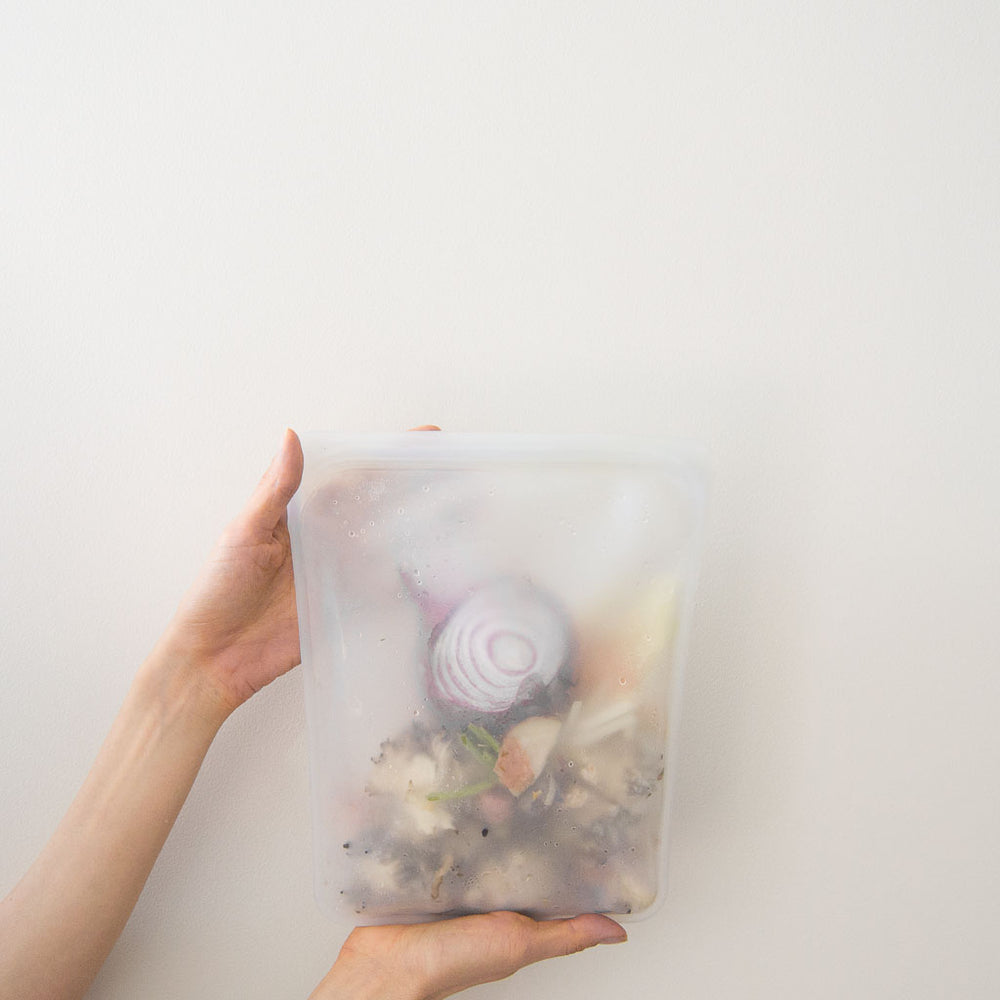Food waste is a huge problem in the United States. 40% of all food in America ends up in the trash, and a family of four throws away over $1800 of food every year.
Before I went minimal, and zero waste, I often felt like I had a fridge full of ‘things,’ yet nothing to eat. I didn’t recognize how privileged I was to be able to buy food whenever I was hungry, and yet I felt guilty each time I found something rotting in my produce drawer. Like many problems we don’t want to acknowledge, I wanted to throw out the moldy food as fast as I could so I didn’t have to confront that I was wasting money, food and taking my privilege for granted.
There is a mental shift when you go zero waste. For me, I started treating my belongings with more care, and that included food. I am much more mindful when I meal plan and grateful to have access to beautiful local fruits and vegetables. Challenging myself to not waste food has helped me become more creative with my cooking and I get so much satisfaction when I get my fridge close to empty before I go to the grocery store.
We can all do better to reduce food waste, and it doesn’t have to be hard. Here are 9 way that you can prevent food waste at home:
1. Stock Up: Keep a reusable silicone bag or glass container in your freezer for vegetable stock scraps. Leftover bits of onions, garlic, mushrooms, tomatoes, potatoes, carrots, herbs, celery, leeks, green beans, scallions, eggplant, winter squash peels and corn cobs make excellent, and flavorful, stock. You’ll want to avoid scraps from cabbage, brussel sprouts, broccoli, cauliflower, artichokes and turnips because their flavors can be overpowering and make the stock bitter.

2. Shop Your Pantry: When you’re planning your meals for the week, challenge yourself to use up as many items as you can from your fridge and pantry. I have found that this not only prevents food waste, and saves money, but it helps me to be more decisive and creative about what I’m going to cook. Creating meals around certain items helps narrow down the possibilities of what you can cook.

3. FIFO. The ol’ “First In, First Out Rule.” Move produce, leftovers, and other items that have been in your fridge awhile towards the front so you're more likely use up those items before you buy new food. I like to plan a veggie stir fry, or kitchen sink salad using up as many items as I can. If fruit is starting to get overripe, I freeze it and make smoothies.

4. Store Properly. Nothing is worse than stocking your fridge with beautiful farmer's market produce, and seeing it go to waste because they haven’t been stored properly. I used to think that plastic bags were the only way to store food in the fridge, but there are so many better zero waste ways to it. Read my post here for a full list of tips on storing fruits and veggies without plastic.

5. Eat Ugly. Have you ever noticed that produce with "flaws" don’t get purchased at the grocery store. And single bananas get tossed to the side. Grocery stores try to only present the most beautiful looking, unblemished produce, because less than perfect apples, potatoes, etc that don’t get purchased get thrown out. I like to think of produce like people—the flaws make it more interesting. The next time you’re shopping, go for the apple with a blemish, the lonely banana, the oddly shaped cucumber, the double-headed kiwi. It will taste just as good, I promise.

6. Freeze Leftovers. I love having leftovers in my fridge. Give me an excuse to not have to think about what I’m going to cook, and I’m there. But sometimes, I get sick of eating the same lunch 3 days in row and then the leftovers can go to waste. I like to freeze a few portions of a big meal, or freeze after day 2, so I have a quick meal when I need it and it doesn’t go to waste when I get burned out on too much vegetable soup.

7. Love Skin. Did you know that the skin of fruits and vegetables are one of the most nutrient-rich parts of the plant? Instead of peeling potatoes, carrots, cucumbers, apples, avoid the waste and eat the skin. Generally speaking, non-peeled produce contains higher amounts of vitamins, minerals, antioxidants and fiber compared to its peeled counterparts.

8. Get Grounded. Have a green thumb, and a coffee habit? Did you know that coffee grounds are excellent for gardening and help add nitrogen to your soil? Grounds are acidic and some acid-loving plants like root vegetables (potatoes, carrots, radishes) love the extra acidity that coffee ground adds to the soil. Worms also love coffee grounds, and some claim that grounds keep pests like snails away.

9. Avoid Clutter. We’ve all been there where we’re looking through our fridge and discover old takeout, past-prime produce and other items that got hidden in the fridge. Do a fridge and pantry purge (of expired, moldy foods) and try to keep your fridge organized and minimal. I like to group things together on the shelves—half eaten apples, onions, limes, tomatoes etc go on the middle shelf. Sauces like pizza sauce, hot sauce, spicy peppers go in one of the door compartments.


